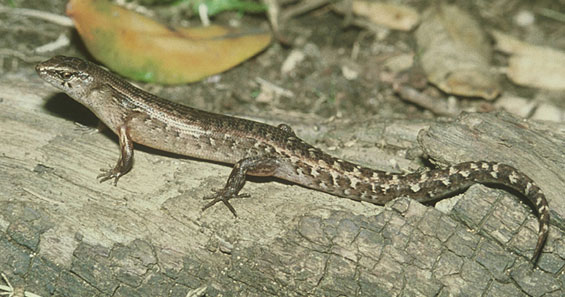The ornate skink is a threatened species, classified as being in “Gradual Decline”—populations are declining over several generations. It is thought that the decline in some places on the mainland may be partly offset by increases on predator-free offshore islands. The survival of this species in the urban environment is uncertain without considerable assistance from people.
Recognition
Ornate skinks can be identified by the attractive markings around their face with a white or yellowish “teardrop” edged with black below each eye. The toes of ornate skinks are relatively short compared to other skinks.

Ornate skinks have attractive markings around their face, including a tear drop below each eye
Behaviour
The small young are born in January- February. Unlike most other skinks world-wide, these young are born live, as do most species of New Zealands skink. The adults are relatively small animals with bodies, excluding the tail, being up to 80 mm long.
Habitat
Ornate skinks inhabit forest or open areas with deep leaf litter, or stable cover such as deep rock piles or thick vegetation.
Ornate skinks prefer damp, humid conditions, and the species is very secretive. Adults have a small home range, often only a few meters if the habitat is suitable, and will exclude other adults.
Gardening tips
Ornate skinks can become active at any time but are mostly active at dawn and dusk (known as crepuscular), seldom emerging from cover. Most people only know that animals are living in the garden because the cat brings them inside.
This threatened species needs protection from all predators, including pet cats and this can be partly achieved by creating a thick and diverse garden that has plenty of cover.
Ensure forested areas or tall scrublands have a layer of shade tolerant ground vegetation. Ferns, swamp musk, renga renga or creeping fuchsia are a good option because they will also help maintain a high humidity.
Deep humus, mulching and an abundance of cover in shady damp areas will be required to encourage ornate skinks into the garden. Naturally damp areas will be favoured.
Around Wellington, ornate skinks have often been found in wandering willie or tradascantia weed infestations. Don’t allow this weed to spread, but also ensure you clear the infestation gradually, replanting thickly with appropriate species as you go.
Ornate skinks like stable plantings, stable temperature and stable humidity, so make changes gradually.